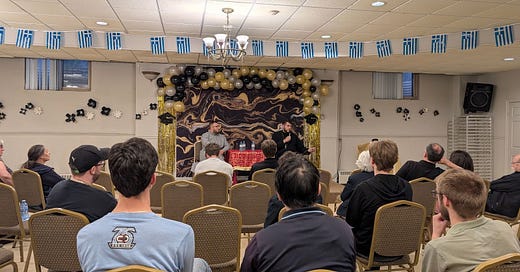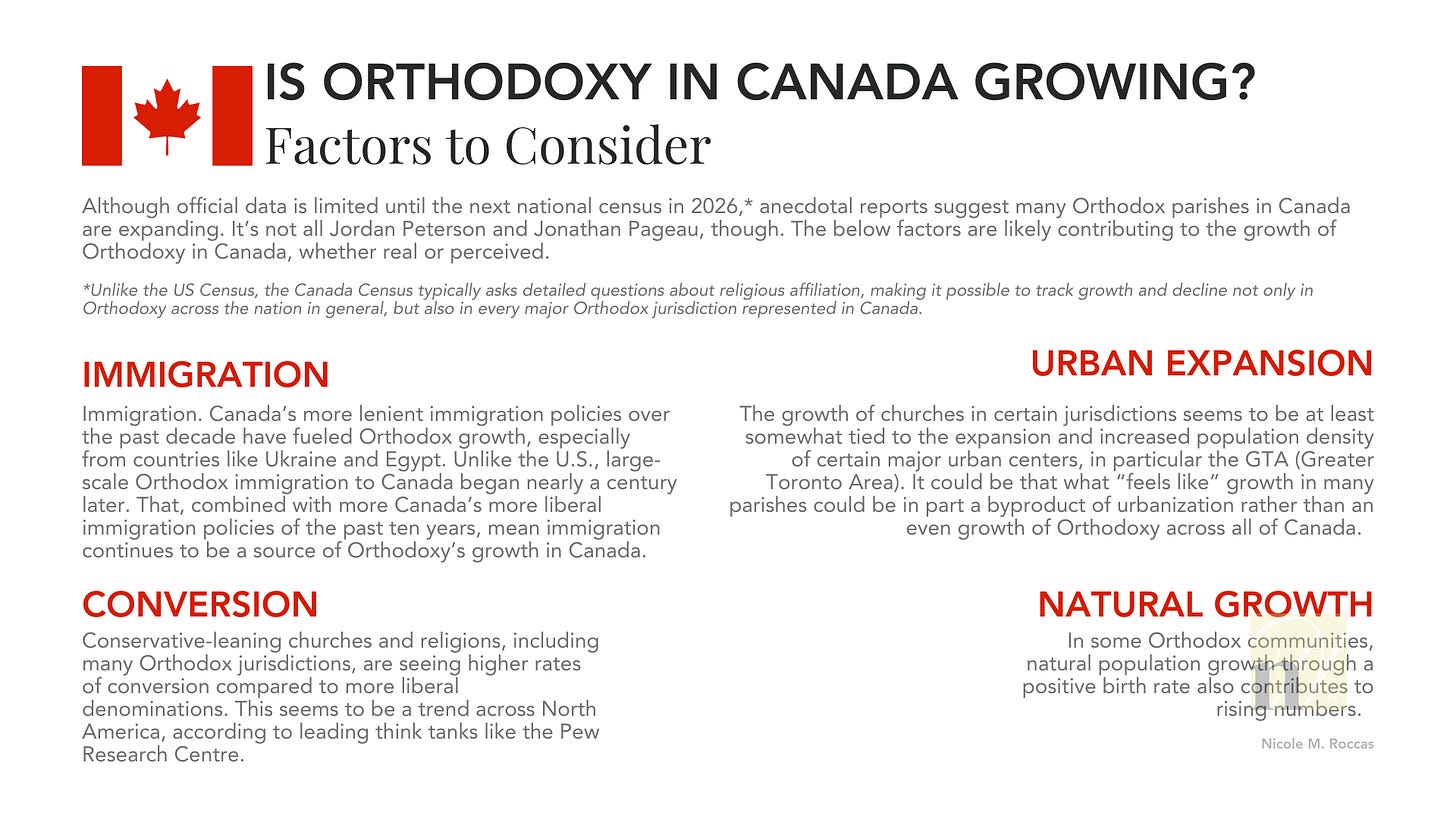What makes the Orthodox Church in Canada distinct today? Where are its greatest strengths—and where is there room to grow? What could the future of Canadian Orthodoxy look like?
These were some of the questions explored during “Orthodoxy in Canada: The Good, the Bad, and the Future,” a cross-jurisdictional panel discussion I attended last night featuring Fr. Yuri Hladio (Orthodox Church in America, Archdiocese of Canada) and Fr. Ted Paraskevopoulos (Greek Orthodox Archdiocese of Canada), moderated by Fr. Bohdan Hladio (Greek Orthodox Archdiocese of Canada, formerly the Ukrainian Orthodox Church of Canada). Both guest speakers serve parishes in southern Ontario and brought thoughtful, complementary perspectives on the past, present, and future of Orthodox Christianity in Canada. As a US expat who has made Canada my home for over a quarter of my life now, I’m still learning and growing in my understanding of what it means to be an Orthodox Christian in this country.
In bringing together voices and audiences across jurisdictions, the event explored shared concerns facing Orthodox communities in Canada—a country that is evolving, expansive, and often divided along regional, ethnic, and jurisdictional lines. In this post, I’ll highlight key takeaways from the event, along with some personal reflections. My goal is to spark thoughtful conversation around the challenges and opportunities for Orthodoxy in Canada, and to offer a record for those who couldn’t attend.
The greatest strengths of Orthodoxy in Canada
The facilitator of the evening, Fr. Bohdan Hladio, opened the discussion by asking the speakers what they believe Orthodoxy in Canada has to offer the broader population. Both speakers were given time to respond. Here are a few of the points they raised:
Consistency and stability.
For Fr. Ted, Orthodoxy is rooted in a beauty and tradition that remain steady, even amid social and economic change. In a world where the pace of life can feel chaotic, Orthodoxy offers a kind of safe harbour—something deeper and more enduring that many people today are longing for.An outsider identity.
For Fr. Yuri, one of Orthodoxy’s strengths in Canada is its “outsider” status. Despite recent growth, it still represents a small portion of the overall population (see my “Orthodoxy in Canada” section below for more context). While this might seem like a disadvantage, it can actually be a strength in a time when many are wary of large institutions and organized religion. Orthodoxy is also an outsider within broader Christianity, having been less shaped by the Enlightenment and other Western frameworks of faith. It offers a witness where mind and body are still connected, and where God is experienced as present and active in ritual, liturgy, tradition, and sacrament. This may not appeal to everyone, but for those seeking spiritual depth outside the usual categories, it presents a meaningful alternative.

What are the greatest weaknesses of Orthodoxy in Canada?
“I am.”
For Fr. Yuri, any authentically Orthodox response to this question must begin with self-examination—reflecting on how we, as individuals, can better align our thoughts, words, and actions with the love of Christ.
At the same time, he acknowledged that Orthodoxy’s strengths in Canada—such as its outsider status—can also be weaknesses. A small footprint means limited resources, influence, and capacity.
Fragmentation and lack of unity.
Fr. Ted echoed Fr. Yuri’s emphasis on inner examination but focused specifically on the role of ego in fueling disunity. Instead of working toward a unified, authentically Canadian expression of Orthodoxy, the current reality is very fractious. We are divided not only between jurisdictions, but within them—even within individual parishes. We get stuck in our own heads, he noted, overly attached to our ideas and arguments, and lose sight of the bigger picture: sharing Christ’s love with the world.
He recalled a visit from Metropolitan Ambrosios (Zografos) of Korea to Toronto years ago. The hierarch celebrated Liturgy at Sts. Panteleimon, Anna & Paraskevi Greek Orthodox Church in Markham, one of the largest Orthodox churches in Canada. A sense of communal pride filled the space—surely the visiting bishop would be impressed by such a gathering. But during his sermon, Metropolitan Ambrosios looked out at the crowd and asked, “Where are all the Canadians?”
For Fr. Ted, that sobering comment has stayed with him. It remains a challenge and a reminder: the Church’s doors must be open to the people and communities around us—not just those who share our ethnicity or language.
Where do we go from here? What would you hope to see happen in the Orthodox Church in Canada in the next 30 years?
At the top of Fr. Yuri’s “wishlist” was the hope for homegrown saints—saints born, raised, and commemorated from within Canadian communities. Having just returned from a family trip to Greece, where nearly every town or village has a saint connected to it, he asked: why not here? For him, the presence of local saints would be a powerful sign that Orthodoxy in Canada is truly alive, regardless of any other demographic trends. But this kind of fruit doesn’t appear overnight. It would require the Church to steward its life well, from catechesis and sacramental life to social witness and community outreach.
Fr. Ted built on this idea by adding another hope: homegrown bishops and clergy. He noted that many ethnically affiliated jurisdictions in Canada still rely on “importing” priests, deacons, and hierarchs from abroad from places like Greece or Russia. Often, these individuals either don’t speak English fluently, but even if they do, they may not understand Canadian culture or the unique challenges faced by people raised here. This creates gaps in pastoral care and ministry.
One common explanation for this trend is clergy shortages. But, as Fr. Ted pointed out, perhaps it’s time to ask why such shortages exist in the first place. What could we do to foster organic growth from within Canada? One potential solution he raised: increase access to English-language theological education and formation within Canada itself.
Q&A
After the initial discussion, about forty-five minutes were set aside for audience questions and comments.
Many of the questions centered around key areas of concern:
Mixed marriages. Several asked about the unique spiritual and pastoral challenges involved in ministering to couples where one partner is Orthodox and the other is not—especially when the non-Orthodox partner converts primarily to be married in the Church. According to Fr. Ted, approximately 70% of marriages in the Greek Orthodox Archdiocese of Canada fall into this “mixed marriage” category.
Engaging younger generations. How can we encourage more active participation from younger people—not just in terms of attending church, but in stepping into service and leadership roles, like parish councils?
Orthodox education. What role should formal Orthodox education play in nurturing faith among children and youth in Canada? Should there be more Orthodox day schools? How should parents weigh options like homeschooling versus public school? Both speakers acknowledged that while Orthodox education may seem ideal in some cases, it means little if parents themselves aren’t actively cultivating faith in the home. Conversely, a strong home environment can help children navigate public education with spiritual resilience, especially with guidance from engaged parents.
Converts and family dynamics. For adult converts—including those who come into the Church through marriage—how can they invite family and friends of other faith backgrounds into Orthodox life in ways that are loving and welcoming, rather than off-putting or alienating?
And then… my own question. I asked about the experiences of women in the Church (you can read it below because I had to type it out in my notes app first—for some reason, unless I’m the official speaker or teacher, I get stage fright in front of groups. Can someone explain that to me?).
The speakers offered thoughtful reflections and agreed this is a real and pressing concern. One immediate step we can take is to elevate the stories of women in our tradition—especially those whose examples challenge rigid or narrow definitions of masculinity and femininity (like the virgin martyrs who resisted marriage). We need to remember the rich diversity of life-giving paths to holiness that Orthodoxy has always upheld, and push back against any attempts to flatten or weaponize gender roles in ways that harm or control.
We also need to listen to the lived experiences of women in our parishes, making space for their stories and creating opportunities for all people to respond to God’s calling—within the Church and beyond.
In Closing
Both priests shared some closing thoughts. Fr. Y reflected on the Parable of the Talents (Matthew 25:14-30) and expressed the hope that we, as members of Orthodox churches in Canada, strive to for a spirit of holy risk. Sometimes, to grow towards God, we have to have the courage to steward and even risk what He has given us instead of trying to keep things from changing. We can see this as a divine adventure, where we set out in a spirit of hope to make the most of what God has entrusted to us, even if we don’t know where it will lead.
Fr. T followed up on this idea, reminding us that it’s possible to change and evolve without compromising the Gospel or core teachings of the church. Even things the outward markers of theological understandings and tradition have changed incrementally over time, yet the core essence of the Church’s witness to the Gospel has stayed the same. We, too, can allow ourselves and our churches to change and grow in obedience to Christ.
All in all, a pretty good event.
Are you an Orthodox person in Canada? How would you have answered these three questions:
What is Orthodoxy in Canada’s greatest strength?
Greatest weakness?
What would you like to see happen in the next 30 years in Canadian Orthodoxy?
Answer in the comments below!
Hey there! Please check out the »Community Guidelines of this blog before commenting. Thanks for helping me continue to make this a safe, supportive, and gracious community.
This post has been lightly copy edited by Chat GPT.








What a great article, Nicole. Thanks for sharing it. I’d love to have something like this in the US.
The bishop’s question to the parish hit me hard. A question worth pondering.
Fr. B
Fascinating discussion, thanks for posting the summary as well as your excellent question. One thing, in your info graphic you mention the relative size of jurisdictions, which I think you got from the census/wikipedia? I believe that the census question is a little misleading, particularly as most OCA/Antiochians would mark themselves as 50% that identified themselves purely as "Christian - Orthodox" etc... . By a combination of church count/active membership I believe the order is Greek(80), Ukrainian(200), OCA(110), Antiochian(30), Russian(25), Romanian(25), Serbian(18), Bulgarian(8), Macedonian(6), ACROD(5) etc... Albanians mentioned have zero active parishes in Canada, even the OCA Albanians...